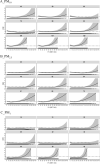The joint effects of physical activity and air pollution on type 2 diabetes in older adults
- PMID: 35650529
- PMCID: PMC9158242
- DOI: 10.1186/s12877-022-03139-8
The joint effects of physical activity and air pollution on type 2 diabetes in older adults
Abstract
Background: Older adults with type 2 diabetes are at higher risk of developing common geriatric syndromes and have a lower quality of life. To prevent type 2 diabetes in older adults, it's unclear whether the health benefits of physical activity (PA) will be influenced by the harms caused by increased exposure to air pollution during PA, especially in developing countries with severe air pollution problem. We aimed to investigate the joint effects of PA and long-term exposure to air pollution on the type 2 diabetes in older adults from China.
Methods: This cross-sectional study was based on the China Multi-Ethnic cohort (CMEC) study. The metabolic equivalent of PA was calculated according to the PA scale during the CMEC baseline survey. High resolution air pollution datasets (PM10, PM2.5 and PM1) were collected from open products. The joint effects were assessed by the marginal structural mean model with generalized propensity score.
Results: A total of 36,562 participants aged 50 to 79 years were included in the study. The prevalence of type 2 diabetes was 10.88%. The mean (SD) level of PA was 24.93 (18.60) MET-h/d, and the mean (SD) level of PM10, PM2.5, and PM1 were 70.00 (23.32) µg/m3, 40.45 (15.66) µg/m3 and 27.62 (6.51) µg/m3, respectively. With PM10 < 92 µg/m3, PM2.5 < 61 µg/m3, and PM1 < 36 µg/m3, the benefit effects of PA on type 2 diabetes was significantly greater than the harms due to PMs when PA levels were roughly below 80 MET-h/d. With PM10 ≥ 92 µg/m3, PM2.5 ≥ 61 µg/m3, and PM1 ≥ 36 µg/m3, the odds ratio (OR) first decreased and then rose rapidly with confidence intervals progressively greater than 1 and break-even points close to or even below 40 MET-h/d.
Conclusions: Our findings implied that for the prevention of type 2 diabetes in older adults, the PA health benefits outweighed the harms of air pollution except in extreme air pollution situations, and suggested that when the air quality of residence is severe, the PA levels should ideally not exceed 40 MET-h/d.
Keywords: Air pollution; Joint effects; Older adults; Physical activity; Type 2 diabetes.
© 2022. The Author(s).
Conflict of interest statement
The authors declare that they have no competing interests.
Figures



Similar articles
-
Associations of long-term exposure to air pollution and physical activity with the risk of systemic inflammation-induced multimorbidity in Chinese adults: results from the China multi-ethnic cohort study (CMEC).BMC Public Health. 2023 Dec 21;23(1):2556. doi: 10.1186/s12889-023-17518-2. BMC Public Health. 2023. PMID: 38129832 Free PMC article.
-
Associations of long-term exposure to ambient air pollution and physical activity with insomnia in Chinese adults.Sci Total Environ. 2021 Oct 20;792:148197. doi: 10.1016/j.scitotenv.2021.148197. Epub 2021 Jun 1. Sci Total Environ. 2021. PMID: 34144234
-
Associations of long-term exposure to air pollution, physical activity with blood pressure and prevalence of hypertension: the China Health and Retirement Longitudinal Study.Front Public Health. 2023 May 3;11:1137118. doi: 10.3389/fpubh.2023.1137118. eCollection 2023. Front Public Health. 2023. PMID: 37206865 Free PMC article.
-
Air Pollution and Potential Health Risk in Ostrava Region - a Review.Cent Eur J Public Health. 2016 Dec;24 Suppl:S4-S17. doi: 10.21101/cejph.a4533. Cent Eur J Public Health. 2016. PMID: 28160532 Review.
-
Association between exposure to ambient air pollution and hospital admission, incidence, and mortality of stroke: an updated systematic review and meta-analysis of more than 23 million participants.Environ Health Prev Med. 2021 Jan 26;26(1):15. doi: 10.1186/s12199-021-00937-1. Environ Health Prev Med. 2021. PMID: 33499804 Free PMC article.
Cited by
-
Physical activity, long-term fine particulate matter exposure and type 2 diabetes incidence: A prospective cohort study.Chronic Dis Transl Med. 2024 May 30;10(3):205-215. doi: 10.1002/cdt3.128. eCollection 2024 Sep. Chronic Dis Transl Med. 2024. PMID: 39027196 Free PMC article.
-
Impact of physical activity levels on the association between air pollution exposures and glycemic indicators in older individuals.Environ Health. 2024 Oct 18;23(1):87. doi: 10.1186/s12940-024-01125-8. Environ Health. 2024. PMID: 39425159 Free PMC article.
-
Eating Spicy Food, Dietary Approaches to Stop Hypertension (DASH) Score, and Their Interaction on Incident Stroke in Southwestern Chinese Aged 30-79: A Prospective Cohort Study.Nutrients. 2023 Feb 28;15(5):1222. doi: 10.3390/nu15051222. Nutrients. 2023. PMID: 36904221 Free PMC article.
-
Does exercise participation promote happiness?: Mediations and heterogeneities.Front Public Health. 2023 Mar 10;11:1033157. doi: 10.3389/fpubh.2023.1033157. eCollection 2023. Front Public Health. 2023. PMID: 36969647 Free PMC article.
-
Long-term particulate matter exposure and the risk of neurological hospitalization: Evidence from causal inference of a large longitudinal cohort in South China.Chemosphere. 2023 Dec;345:140397. doi: 10.1016/j.chemosphere.2023.140397. Epub 2023 Oct 12. Chemosphere. 2023. PMID: 37838030 Free PMC article.
References
-
- Mohan V, Khunti K, Chan SP, Filho FF, Tran NQ, Ramaiya K, et al. Management of Type 2 Diabetes in Developing Countries: Balancing Optimal Glycaemic Control and Outcomes with Affordability and Accessibility to Treatment. Diabetes Ther. 2020;11(1):15–35. doi: 10.1007/s13300-019-00733-9. - DOI - PMC - PubMed
-
- International Diabetes Federation. IDF Diabetes Atlas, 9th edn. Brussels: International Diabetes Federation; 2019.
Publication types
MeSH terms
Substances
LinkOut - more resources
Full Text Sources
Medical
Miscellaneous

